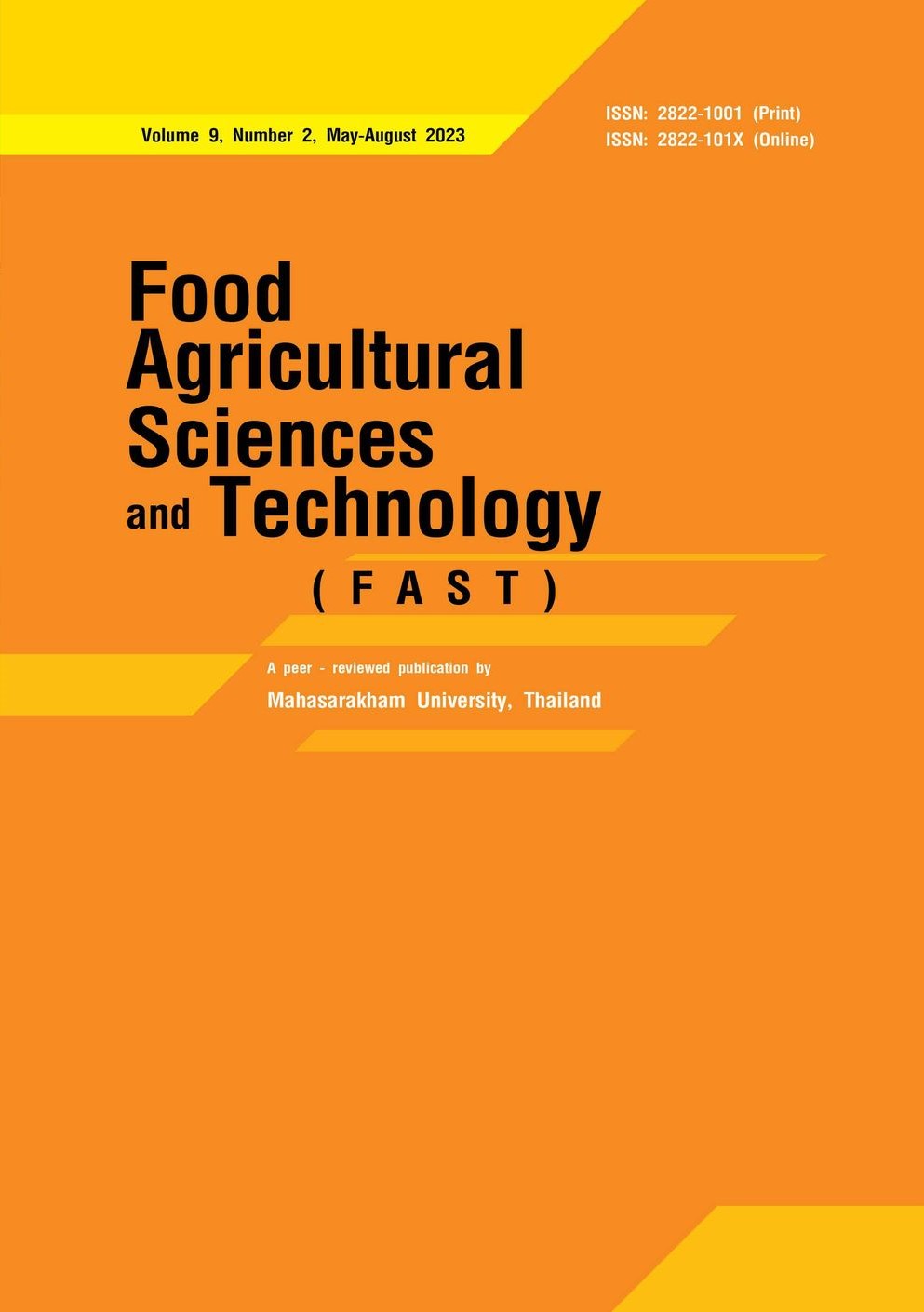Processing of red palm oil by modified acid degumming method
Keywords:
Crude palm oil, acid degumming, red palm oilAbstract
Red palm oil (RPO) is a high carotenoids product that resulted from crude palm oil (CPO). The conventional process of RPO includes degumming, neutralization, deodorization, and fractionation processes. This research aimed to develop the simple and economical acid degumming method for processing of red palm oil. 85% phosphoric and 99.5% citric acid were used and the factors used in the study were acid (phosphoric:citric acid 0.06:0.04,0.08:0.02,0.10:0 % w/w), temperature (90, 100, 110 °C) and time (20, 25, 30 minutes). The sample was stirred at 200 rpm. In addition, the neutralization process was further studied. The results indicated that the optimal condition for degumming was 90 °C for 20 minutes and the optimum ratio of acid to separate the gum is 0.06% phosphoric acid (w/w) and 0.04% citric acid (w/w) citric acid. The sedimented gum was separated from the oil by washing the oil with water at 60 °C. After degumming the oil contained 82.70±6.49% yield carotenoids, 3.50±0.55% free fatty acid (FFA), 3.01±0.73 umol Trolox eq/g DPPH-free radical scavenging activities and 4.43±0.05 umol Trolox eq/g FRAP-free radical scavenging activities. The free fatty acids and phosphorus content were separated by NaOH at 80 °C for 30 min with constant stirring. Soap from the saponification reaction and excess NaOH were washed out with water at 60 °C. After neutralization, the oil contained 0.46±0.05% fatty acids, 637.60±8.64 mg/kg carotenoids, 74.48±9.39% oil yield, ˂ 0.1 mg/kg iron, the copper and phosphorus contents were not detected.
References
AOAC. (2000). Official methods of analysis (20th ed.). Association of Official Analytical Chemists, USA.
AOAC. (2016). Official methods of analysis (19th ed.). Association of Official Analytical Chemists, USA. Azis, H. R., Tien, R. M., Nuri, A., & Tri, H. (2016). Pilot plant study of red palm oil deodorization using moderate temperature. Agriculture and Agricultural Science Procedia 9, 209-216. https://doi: 10.1016/j. aaspro.2016.02.129
Bonnie, T. Y. P., & Choo, Y. M. (1999). Valuable minor constituents of commercial red palm olein: carotenoids, vitamin E, ubiquinones and sterols. Proceedings of the 1999 PORIM. International Palm Oil Congress (Chemistry and Technology)(pp. 97-108). Institute of Malaysia.
Chaijan, M., & Panpipat, W. (2021). Pre-neutralized crude palm oil as natural colorant and bioactive ingredient in fish sausage prepared from tilapia (Oreochromis niloticus). LWT-Food Science and Technology, 135, 110289. https://doi.org /10.1016/j.lwt.2020.110289
Chompoo, M., Damrongwattanakool, D., & Raviyan, P. (2019). Effect of chemical degumming process on physicochemical properties of red palm oil. Songklanakarin Journal of Science and Technology, 41(3), 513-521.
Codex Alimentarius International Food Standards. (1999). Standard for named vegetable oils. CODEX STAN 210-1999. https://doi. org/10.1016/ j.lwt.2020.110289
De Greyt, W. (2013). Edible oil refining: current and future technologies. In Wolf Hamm, Richard J. Hamilton & Gijs Calliauw (Eds). Edible Oil Processing (pp. 127-151). Wiley-Blackwell. DOI:10.1002/ 9781118535202
Dijkstra, A. J. (2017). About water degumming and the hydration of non- hydratable phosphatides. European Journal of Lipid Science and Technology, 119(9), 1-11. https:// doi.org/10.1002/ejlt.201600496
Jiang, X., Chang, M., Jin, Q., & Wang, X. (2015). Application of phospholipase A1 and phospholipase C in the degumming process of different kinds of crude oils. Process Biochemistry, 50(3), 432-437. https://doi.org/10.1016/j. procbio.2014.12.011
Lee, J. M., Chung, P. S., & Lee, J. H. (2007). Development of a method predicting the oxidative stability of edible oils using 2, 2-diphenyl-1-picrylhydrazyl (DPPH). Journal of Food Chemistry, 103, 662-669. http://doi:10.1016/j. foodchem.2006.07.052
Mah, S. H., Teh, S. S., & Ee, G. C. L. (2017). Anti-inflammatory, anti-cholinergic and cytotoxic effects of Sida rhombifolia. Pharmaceutical Biology, 55(1), 920-928. https://doi:10.1080/138 80209.2017.1285322
Mansouri, A., Embarek, G., Kokkalou, E., & Kefalas, P. (2005). Phenolic profile and antioxidant activity of the Algerian ripe date palm fruit (Phoenix dactylifera). Food Chemistry, 89(3), 411-420. https://doi.org/10.1016/j. foodchem.2004.02.051
Mayamol, P. N., Balachandran, C., Samuel, T., Sundaresan, A., & Arumughan, C. (2007). Process technology for the production of micronutrient rich red palm olein. American Oil Chemists’ Society, 84, 587-596.
Nagendran, B., Unnithan, U. R., Choo, Y. M., & Sundram, K. (2000). Characteristics of red palm oil, a carotene-and vitamin E-rich refined oil for food uses. Food and Nutrition Bulletin, 21(2), 189-194. https://doi. org/10.1177/156482650002100213
Paisan, S., Chetpattanasnondh, P., & Chongkhong, S. (2017). Assessment of water degumming and acid degumming of mixed algal oil. Environmental Chemical Engineering, 5(5), 5115-5123. https:// doi.org/10.1016/j.jece.2017.09.045
Pratik, V., & Surekha, D. (2018). Refining of palm oil: A review on palm oil refining process, 3-MCPD esters in refined palm oil, and possible reduction tactics for 3-MCPD esters. International Journal of Agricultural Engineering, 11, 81-85. DOI:10.15740/has/ijae/11. sp.issue/81-85
Ribeiro, H. S., Chu, B. S., Ichikawa, S., & Nakajima, M. (2008). Preparation of nano dispersions containing β- carotene by solvent displacement method. Food Hydrocolloids, 22(1), 12-17. https://doi.org/10.1016/ j.foodhyd.2007.04.009
Rinćon, L. A., Ramírez, J. C., & Orjuela, A. (2020). Assessment of degumming and bleaching processes for used cooking oils upgrading into oleochemical feedstocks. Environmental Chemical Engineering, 9(1). https://doi. org/10.1016/j.jece.2020.104610
Rossi, M., Alamprese, C., & Ratti, S. (2007). Tocopherols and tocotrienols as free radical scavengers in refined vegetable oil and their stability during deep- fat frying. Food Chemistry, 102(3), 812- 817. https://doi.org/10.1016/j. foodchem.2006.06.016
Shahidi, F. (2005). Palm oil. Bailey’s Industrial Oil and Fat Products. https://doi. org/10.1002/047167849X.bio071
Sulihatimarsyila, A. W. N., Lau, H. L. N., Nabilah, K. M., & Azreena, I. N. (2019). Refining process for production of refined palm-pressed fibre oil. Industrial Crops and Products, 129, 488-494. https://doi. org/ 10.1016/j.indcrop.2018.12.034
Sulihatimarsyila, A. W. N., Lau, H. L. N., Nabilah, K. M., & Azreena, I.N. (2020). Production of refined red palm- pressed fibre oil from physical refining pilot plant. Case Studies in Chemical and Environmental Engineering, 2, 100035. https://doi. org/10.1016/j.cscee.2020.100035
Szydlowska-Czerniak, A. (2007). MIR spectroscopy and partial least-squares regression for determination of phospholipids in rapeseed oils at various stages of technological process. Food Chemistry, 105(3), 1179- 1187. https://doi.org/10.1016/j. foodchem.2007.02.038
Unnithan, U. R., Foo, S. P., & Elanko, S. (2011). Market development of red palm fruit oil and its contribution in Africa and southeast Asia. Palm Oil Development, 55, 20-24.
Varzakas, T., & Kiokias, S. (2016). HPLC analysis and determination of carotenoid pigments in commercially available plant extract. Nutrition and Food Science, 4, 1-14.
Downloads
Published
Issue
Section
License
Copyright (c) 2023 Food Agricultural Sciences and Technology (FAST)

This work is licensed under a Creative Commons Attribution-NoDerivatives 4.0 International License.





